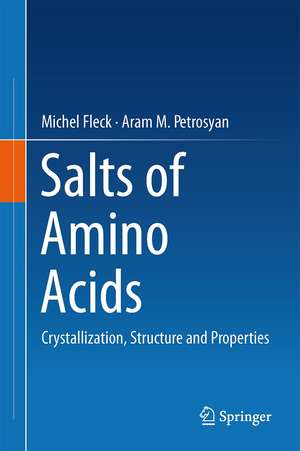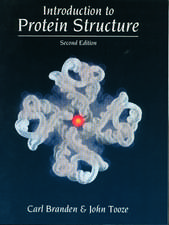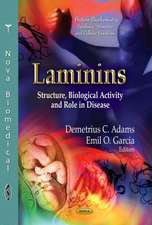Salts of Amino Acids: Crystallization, Structure and Properties
Autor Michel Fleck, Aram M. Petrosyanen Limba Engleză Hardback – 28 iul 2014
| Toate formatele și edițiile | Preț | Express |
|---|---|---|
| Paperback (1) | 1009.98 lei 38-44 zile | |
| Springer International Publishing – 16 sep 2016 | 1009.98 lei 38-44 zile | |
| Hardback (1) | 964.40 lei 43-57 zile | |
| Springer International Publishing – 28 iul 2014 | 964.40 lei 43-57 zile |
Preț: 964.40 lei
Preț vechi: 1176.11 lei
-18% Nou
Puncte Express: 1447
Preț estimativ în valută:
184.60€ • 200.58$ • 155.16£
184.60€ • 200.58$ • 155.16£
Carte tipărită la comandă
Livrare economică 21 aprilie-05 mai
Preluare comenzi: 021 569.72.76
Specificații
ISBN-13: 9783319062983
ISBN-10: 3319062980
Pagini: 574
Ilustrații: IX, 574 p. 232 illus., 145 illus. in color.
Dimensiuni: 155 x 235 x 27 mm
Greutate: 0.99 kg
Ediția:2014
Editura: Springer International Publishing
Colecția Springer
Locul publicării:Cham, Switzerland
ISBN-10: 3319062980
Pagini: 574
Ilustrații: IX, 574 p. 232 illus., 145 illus. in color.
Dimensiuni: 155 x 235 x 27 mm
Greutate: 0.99 kg
Ediția:2014
Editura: Springer International Publishing
Colecția Springer
Locul publicării:Cham, Switzerland
Public țintă
ResearchCuprins
Preface
1. Introduction
1.1 What are amino acids?
1.2 Naming amino acids
1.3 Configuration: Chirality and optical activity
1.4 Conformation: Molecular shape and stability
1.5 Cations, Anion, Zwitterions
1.6 Concluding remarks
References
2. Amino acid structures
2.1 Introducing remarks
2.2 Solubility and crystal growth
2.3 Amino acid structures
2.4 Summary
References
3. Compounds of amino acids and cations
3.1 Introducing remarks
3.2 Glycine
3.3 Alanine
3.4 Valine, Leucine, Isoleucine
3.5 Proline, Methionine, Phenylalanine, Tryptophan
3.6 Serine and Threonine
3.7 Cysteine
3.8 Asparagine, Glutamine, Aspartic acid and Glutamic acid
3.9 Tyrosine, Histidine, Lysine, Arginine
3.10 Non-Standard Amino Acids
3.11 Concluding Remarks
References
4. Compounds of amino acids and neutral salts
4.1 Introducing remarks
4.2 Glycine
4.3 Alanine
4.4 Valine, Leucine, Isoleucine
4.5 Proline, Methionine, Phenylalanine, Tryptophan
4.6 Serine, Threonine, Cysteine
4.7 Asparagine, Glutamine, Aspartic acid, Glutamic acid
4.8 Tyrosine, Histidine, Lysine, Arginine
4.9 β-Alanine
4.10 Betaine4.11 Other non-standard amino acids
4.12 Concluding Remarks
References
5. Reactions of amino acids with acids
5.1. Simple salts
5.2. Salts of amino acids with dimeric cations
5.3. Mixed salts of amino acids with different anions and cations
References
1. Introduction
1.1 What are amino acids?
1.2 Naming amino acids
1.3 Configuration: Chirality and optical activity
1.4 Conformation: Molecular shape and stability
1.5 Cations, Anion, Zwitterions
1.6 Concluding remarks
References
2. Amino acid structures
2.1 Introducing remarks
2.2 Solubility and crystal growth
2.3 Amino acid structures
2.4 Summary
References
3. Compounds of amino acids and cations
3.1 Introducing remarks
3.2 Glycine
3.3 Alanine
3.4 Valine, Leucine, Isoleucine
3.5 Proline, Methionine, Phenylalanine, Tryptophan
3.6 Serine and Threonine
3.7 Cysteine
3.8 Asparagine, Glutamine, Aspartic acid and Glutamic acid
3.9 Tyrosine, Histidine, Lysine, Arginine
3.10 Non-Standard Amino Acids
3.11 Concluding Remarks
References
4. Compounds of amino acids and neutral salts
4.1 Introducing remarks
4.2 Glycine
4.3 Alanine
4.4 Valine, Leucine, Isoleucine
4.5 Proline, Methionine, Phenylalanine, Tryptophan
4.6 Serine, Threonine, Cysteine
4.7 Asparagine, Glutamine, Aspartic acid, Glutamic acid
4.8 Tyrosine, Histidine, Lysine, Arginine
4.9 β-Alanine
4.10 Betaine4.11 Other non-standard amino acids
4.12 Concluding Remarks
References
5. Reactions of amino acids with acids
5.1. Simple salts
5.2. Salts of amino acids with dimeric cations
5.3. Mixed salts of amino acids with different anions and cations
References
Textul de pe ultima copertă
This book is about amino acid salts and presents comprehensive data, including crystallographic parameters in easily accessible tables, for quick identification. The work describes amino acids and their salts with cations, anions and compounds from a chemical, physical and crystallographical point of view: crystal structures, molecular structures and polymorphs are explored. Readers will find additional data on structural properties, crystal growth, and the relation of structure and physical properties of amino acid salts.
This work covers a wide range of relevant topics, from the discovery of important ferroelectrics or non-linear optical materials, to nutrients, flavor enhancers or drugs. Apart from their biological function, this family of organic compounds has been employed in the synthesis of a vast variety of salts.
Common mistakes and pitfalls in research on amino acid salts are explained so that the reader can avoid them, and numerous figures are included to provide a visual overview of structural aspects of amino acid salts.
Since amino acids have been found to be of importance in many fields, this work will appeal across the sciences. Amino acids and their salts have an impact on materials science and on pharmaceutical and physics research, whilst professional practitioners in the fields of chemistry and food science will also find this work and the data presented here of value.
This work covers a wide range of relevant topics, from the discovery of important ferroelectrics or non-linear optical materials, to nutrients, flavor enhancers or drugs. Apart from their biological function, this family of organic compounds has been employed in the synthesis of a vast variety of salts.
Common mistakes and pitfalls in research on amino acid salts are explained so that the reader can avoid them, and numerous figures are included to provide a visual overview of structural aspects of amino acid salts.
Since amino acids have been found to be of importance in many fields, this work will appeal across the sciences. Amino acids and their salts have an impact on materials science and on pharmaceutical and physics research, whilst professional practitioners in the fields of chemistry and food science will also find this work and the data presented here of value.
Caracteristici
Comprehensive data on all amino acid salts published to data, key data (crystallographic parameters) for quick identification easily accessible in Tables
Common mistakes and pitfalls are explained so to be avoided in research on amino acid salts
Numerous Figures provide visual overview of structural aspects of amino acid salts
Relevant issues that help to understand the main work are explained in boxes accompanying the text
Common mistakes and pitfalls are explained so to be avoided in research on amino acid salts
Numerous Figures provide visual overview of structural aspects of amino acid salts
Relevant issues that help to understand the main work are explained in boxes accompanying the text













